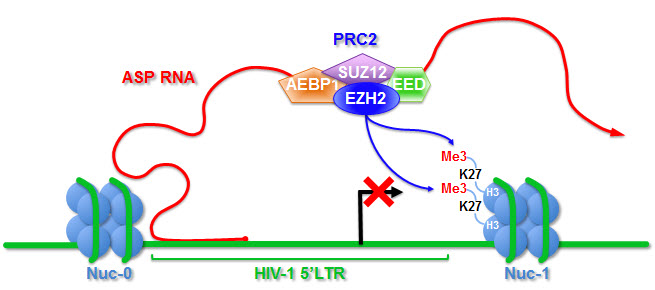
How HIV-1 puts itself to sleep
Read the full article on ScienceDirect, open access.
Read about the antisense ASP RNA acting as viral latency factor
Text by Fabio Romerio
Upon infection of a new cell, the HIV-1 genome integrates into the genome of the host cell, and in this form HIV-1 is known as a provirus. Under proper cellular conditions, the HIV-1 provirus produces the transactivator Tat that drives efficient expression of the viral genome, leading to the production of new viral particles. Alternatively, the provirus remains silent in a status known as latency. In our study, we demonstrated that HIV-1 encodes an antisense transcript (ASP) that recruits the cellular Polycomb Repressor Complex 2 (PRC2) to the proviral 5’LTR. PRC2 promotes nucleosome assembly at the 5’LTR, leading to transcription silencing and proviral latency. While active regulation of proviral expression by Tat has long been known, latency was thought to be a passive event caused primarily by the absence of key cellular and viral transcription factors. Our study demonstrated that – on the contrary – HIV-1 also regulates the establishment and maintenance of latency through ASP, and therefore it controls all aspects of its destiny.
The impetus for this study happened – as often is the case – very serendipitously. Our lab became interested in the presence of antisense transcription in human retroviruses, HTLV-1 and HIV-1 – a research area that was relatively unexplored. There was some evidence in the literature that these antisense transcripts play a role in viral expression, but the mechanism was yet to be described. During an informal discussion, a friend and colleague – Dr. Rosa Bernardi – brought to our attention that many cellular antisense transcripts suppress the expression of their cognate sense transcript by tethering chromatin modifying protein complexes to their promoter regions, and by inducing nucleosome formation and transcriptional silencing.
This inspired us to use RNA immunoprecipitation (RIP) assays to test whether the HIV-1 antisense RNA (ASP) interacts with members of the PRC2 complex. However, our initial efforts were repeatedly unsuccessful. Discouraged by these negative results, we decided to focus on other projects in the lab. After a few months we revisited these experiments, and we realized that there was a problem in the design of the RT-PCR portion of the RIP assay. After making the necessary modifications to the RT-PCR assay, we were finally able to demonstrate specific interaction between the ASP RNA and two components of the PRC2 complex. This important result encouraged us to further pursue this line of studies. The “eureka” moment came shortly after that when functional studies showed that over-expression of the ASP RNA in vivo suppresses acute viral replication and promotes the establishment and maintenance of latency.
Our current efforts are focused on defining the structural and functional determinants of the ASP RNA. Since this transcript contains an open reading frame, we are also investigating the expression and function of the ASP protein.
